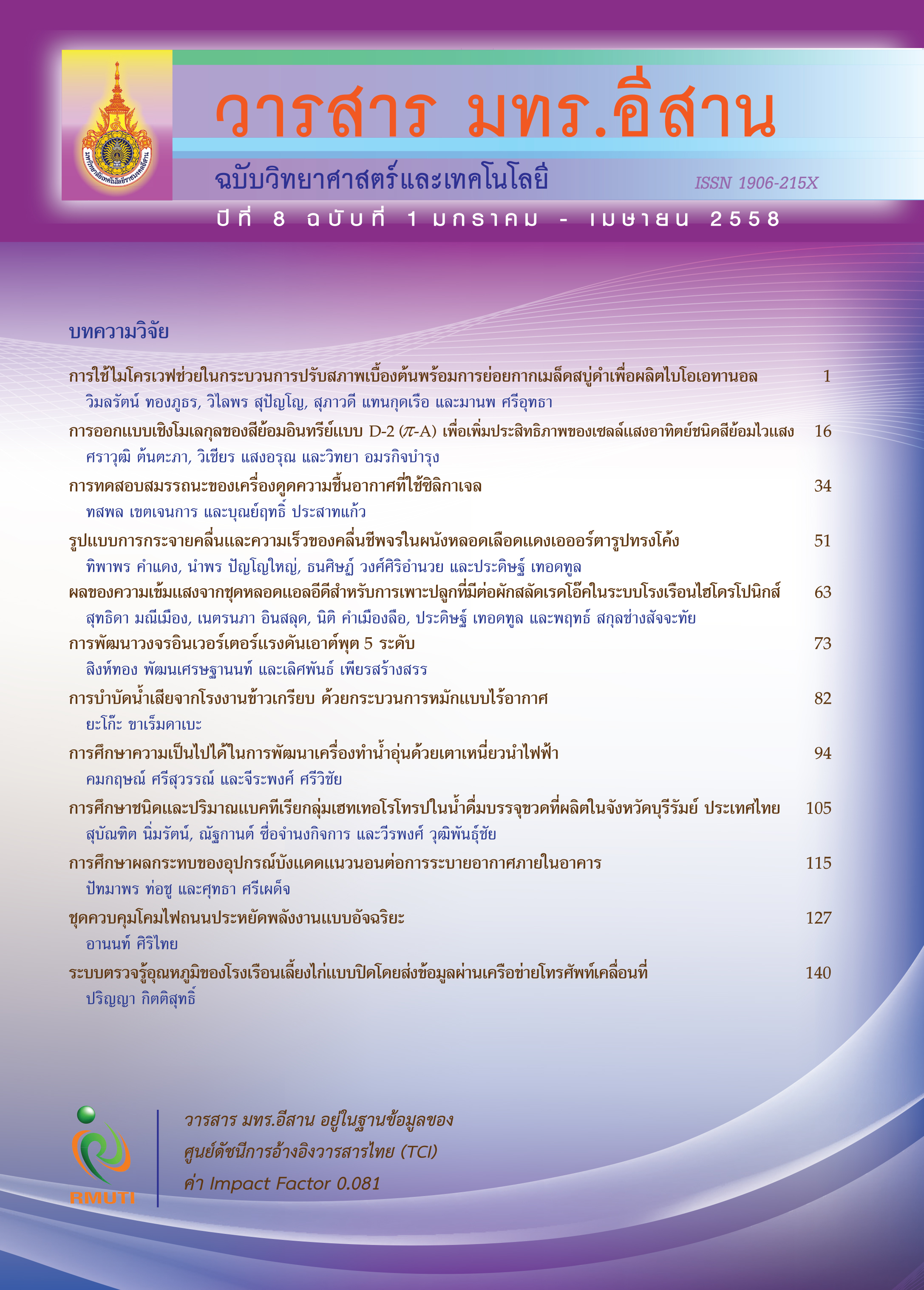การทดสอบสมรรถนะของเครื่องดูดความชื้นอากาศที่ใช้ซิลิกาเจล
Main Article Content
Abstract
บทความนี้รายงานผลการทดสอบสมรรถนะของเครื่องดูดความชื้นอากาศที่ใช้ซิลิกาเจลซึ่งออกแบบไว้สำหรับใช้ในพื้นที่ปรับอากาศ โดยได้ทำการแปรค่าความเร็วของอากาศที่ 0.2, 0.4 และ 0.6 m/s (สอดคล้องกับอัตราการไหลของอากาศในช่วง 0.008 ถึง 0.140 m3/s) แปรค่าปริมาณซิลิกาเจลที่ 10, 15 และ 20 kg และแปรค่าความหนาของชั้นซิลิกาเจลที่ 0.1, 0.2 และ 0.3 m การทดลองทั้งหมดทำในห้อง
ขนาด 8 m x 10 m x 3 m ที่มีการควบคุมอุณหภูมิด้วยเครื่องปรับอากาศไว้ที่ 25oC การทดลองทุกชุดทำในเวลากลางวัน เป็นระยะเวลา 4 ชั่วโมงต่อชุด เพื่อให้แน่ใจว่าสารดูดความชื้นจะอิ่มตัว สมรรถนะของการดูดความชื้นในงานนี้ใช้อัตราการดูดความชื้นเป็นตัวชี้วัด ผลการทดลองแสดงให้เห็นว่าอัตราการดูดความชื้นเพิ่มขึ้น เมื่อความเร็วของอากาศและปริมาณของสารดูดความชื้นเพิ่มขึ้น และจะลดลงเมื่อความหนาของชั้นสารดูดความชื้นลดลง ดังนั้น เครื่องดูดความชื้นควรออกแบบให้ทำงานที่ความเร็วลมและปริมาณสารดูดความชื้นสูง ในขณะที่ความหนาของชั้นสารดูดความชื้นควรจะน้อย ในภาพรวมเครื่องดูดความชื้นนี้ดูดซับความชื้นได้ 0.026 x 10-3 ถึง 0.381 x 10-3 kgw/s (0.38 ถึง 5.59 kgw/4 h) อัตราการดูดความชื้นเฉลี่ยมีค่าเท่ากับ 0.092 x 10-3 kgw/s (1.33 kgw/4 h) ส่วนอุณหภูมิ สัดส่วน ความชื้น และความชื้นสัมพัทธ์เฉลี่ยของอากาศที่ออกจากเครื่องดูดความชื้นมีค่า 33.09oC, 0.0093 kgw/kgda
และ 30.51% ตามลำดับ
This article reports the performance test of a silica gel dehumidifier intended to use inside air conditioned spaces. The air velocity was varied at 0.2, 0.4, and 0.6 m/s (corresponding to the air flow rate within a range of 0.008 to 0.140 m3/s); the amount of the solid desiccant was varied at 10, 15, and 20 kg; and the thickness of the desiccant bed was varied at 0.1, 0.2 and 0.3 m. All experiments were carried out in an 8 m x 10 m x 3 m room where the temperature was controlled at 25oC by an air conditioner. Each set of experiments was run during daytime for a period of
4 hours to ensure that the desiccant was saturated. The moisture adsorption rate was considered as the performance indicator. The results showed that the moisture adsorption rate increased with the air velocity and the desiccant amount while it decreased with the bed thickness. Therefore, the ehumidifier should operate at high desiccant amount and air velocity while the bed thickness should be low. Overall, the dehumidifier adsorbed moisture within a range of 0.026 x 10-3 to 0.381 x 10-3 kgw/s (0.38 to 5.59 kgw/4 h). The average moisture adsorption rate was 0.092 x 10-3 kgw/s (1.33 kgw/4 h). The average temperature, humidity ratio, and relative humidity of the outlet air were found to be 33.09oC, 0.0093 kgw/kgda and 30.51%, respectively.


